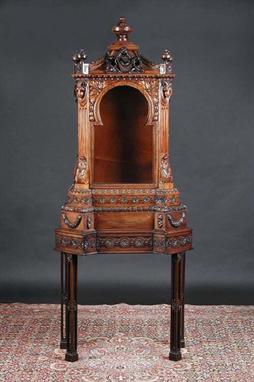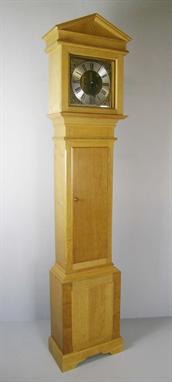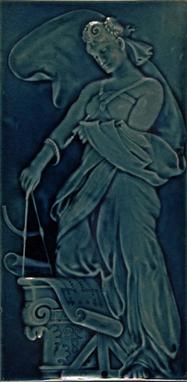We found 35023 price guide item(s) matching your search
There are 35023 lots that match your search criteria. Subscribe now to get instant access to the full price guide service.
Click here to subscribe- List
- Grid
-
35023 item(s)/page
A 16th Century Italian Cedarwood Panel Mounted in a Gillows Overmantel Frame. The 'Adige' Chest front divided by moulding into three panels depicting in detailed pen-work court scenes silhouetted against a recessed mesh punched ground and flanked by gentlemen standing under architectural domed facades. The centre panel surmounted by two lions & cartouche with protruding armorial crest, flanked by four cherubs seated under arches. Set within an overmantel frame stamped Gillows & Co. 13673. 28½ ins (70 cms) high, 70½ ins (179 cms) long, 5¼ ins (13½ cms) deep.
French walnut two train mantel clock, the Japy Freres movement no. 7147 with outside countwheel striking on a gong, the 4.5" black slate dial with recessed floral centre within an architectural case with canted pilasters, 9.5" high; also an Art Deco two train mantel clock striking on a gong, the 4.25" square silvered dial within an inlaid case, 7.25" high (2)
A Meissen square architectural shaped teapot and cover, with vestal knop, the sides painted with birds or insects between pink and gilt pillars, 12cm h, wheel cut crossed swords mark in underglaze blue, c1800; a Meissen globular teapot and cover, Marcolini period, painted with flowers, 14.5cm h, wheel cut crossed swords and * in underglaze blue, c1800; a similar, smaller Berlin teapot and cover, painted sceptre in underglaze blue, c1800 (6) ++Square teapot and cover - restoration to the corners (the columns). Marcolini teapot and cover - in good condition, the cover associated. Berlin teapot and cover - spout restored. The cover secured by a chain
A Victorian oak bracket clock, the arched brass dial with matted centre signed on a tablet Morath Bros Liverpool and with three subsidiary dials above, one inscribed CHIME ON EIGHT BELLS/CHIME ON FOUR GONGS, the triple fusee movement with spotted plates, carillon and two coiled wire gongs, in architectural case with open pediment, carved paterae and fluted pillars, on conforming bracket, 87cm h overall, printed label to the reverse of the bracket of SPENCER BROS REMOVAL CONTRACTORS LIVERPOOL stamped in purple ink CAPT W C MUMFORD (2) ++Slight damage to the fretwork on the rear door and to a lesser extent the side panel, the pediment is slightly chipped on both sides but in otherwise excellent entirely original condition
A George II oak bureau, the architectural stepped interior with pierced, break arched door in blind fret surround, the front fitted three moulded drawers above three further graduated drawers, on bracket feet, 107cm h; 92 x 48cm ++The handles and key plates Victorian gilt brass replacements, stamped WT&S beneath a sun. In basically good original condition with small losses to the narrow parts of the moulding around several of the drawers
A pair of Jules Loebnitz & Fils faience architectural panels, modelled in high relief by J Hugues, signed and brightly painted with the full length figures of a dancing girl or windswept young woman with flowers, both with blue painted mark J LOEVNITZ & FILS PARIS, one inscribed "A Monsieur Clemencet Souvenir d'Avril 1894" and signed J Blanchard, 55 x 25.5cm, impressed J LOEBNITZ PARIS, 1894 These rare panels of the Belle Epoque are contemporary smaller versions of the pair which form the focal point of the facade of the Cafe Riche in Paris. Commissioned by the architect Albert Ballu (1849-1939) they are now in Rouen Museum. The Cafe Riche, which was completed in 1894 and dismantled only four years later, was aptly named for its ornate decoration also included elaborate polychrome mosaics and it became a popular haunt of the Impressionists, including Monet, Renoir and Degas. ++One panel with small triangular shaped piece of the lower left corner broken off and glued back into position also with minor edge and corner knocks. Both with odd spot of flaking of the enamel where most thickly applied or highest relief. No professional restoration.
An eight day longcase clock, oak, the 11" square brass dial with chapter ring of Roman numerals, the 19th century movement striking on a single bell, the oak case made in the 18th century style, circa 1990s, the hood with architectural pediment carved with a 'W' to the frieze, over a short trunk door, box base on shaped bracket feet, 210cm high. Provenance: Case made by Robert Wearing.
Attributed to Gustav Friedrich Hetsch (German, 1788-1864) The Cloisters of St Lorenzo Without, Rome, signed lower right with monogram and date of 1862, pen, ink and wash, 27 x 30cm; Fred Foster (British, fl.1836-1876) Architectural Study, signed lower right "Fred Foster 1838" pencil, 26 x 33cm; together with Munster Mayfeldt, July 23 1836 pencil 26 x 18cm; Francesco Gonin (Italian, 1808-1889) Architectural Study, signed lower left "F Gonin 1833" pen and ink, 26 x 36cm; R Palmieri (Italian, 19th Century) Interior of a Great Hall, signed lower right "R Palmieri Disegno 1832" pencil, 28 x 36cm (5)
Norzi, Raphael Marpe Lanephesh. Venice: Giovanni di Gara, 1579. Small. 4to. ff. 26, Hebrew letter, title within splendid architectural border, censores autograph at end, modern boards Note: BM STC It. p. 549. Vinograd 638. Habermann, di Gara 638.. One of three tracts on ethics originally issued, but now rarely found, together. The first edition of this work came out in 1561. The work posits rational ethical answers to religious questions.
Ariosto, Ludovico Orlando furioso. Venice: Domenico & Gio. Battista Guerra, 1575, small 4to, unpaginated [596, 73], 2 engraved titles with views of Venice, 51 engraved architectural text pages, 18th century calf gilt, hinges splitting, title slightly dusty, some slight staining, bookplate Provenance: Armorial bookplate of Sir Thomas Cochrane [1775-1860], a Scots-born admiral who obtained his knighthood after coordinating the successful destruction of the French fleet blockade in Aix roads in 1809. His reputation would suffer in 1814 when he was charged with fraud for propagating the rumour of Napoleones overthrow. He was eventually reinstated as rear-admiral and Commander-in-Chief of the North America station. Not in Adams.
Bible-New Testament, polyglot Le nouveau testament... the New Testament... het Nieuwe Testament. Amsterdam: Steven Swart Jacobus vander Deyster en Aert Dircksz Oofsaen, 1684, 12mo, engraved title with architectural border, printed in three columns in French, Dutch and English, nineteenth-century light brown morocco, double gilt fillet on sides, neatly rebacked retaining original spine Note: A polyglot New Testament in three modern languages. Herbert 795; D. & M. 626 Provenance: Baptist College Bristol, presentation inscription from Jon. E. Ryland; Baptist College, Bristol, bookplate
Collado, Luis. Pratica manuale di artiglieria. Venice: Pietro Dusinelli 1586. First edition, folio, [vi] 92 ll, woodcut architectural titlepage, central arms of the dedicatee ÔDon Carlo deAragonae, 2 woodcut plates, 6 full-page and 29 text woodcut illustrations, woodcut initials and ornaments, contemporary limp vellum, some patches of wear, two small wormtrails [one touching a few letters], very slight marginal stains or thumbing, very early small armorial stamp on titlepage, a few marginal annotations in a later Italian hand Note: Luis Collado was engineer of the Spanish army in Italy during the last quarter of the 16th century. First edition of his important work on artillery, according to Cockle Ôthe only edition of the original form of Colladoes famous work.e 126 chapters deal with all aspects of this topic, including: the qualities and duties of gunner generals and other officers; naval artillery; the invention of gunpowder; the casting, possible defects, uses, pieces, proportions, etc., of various types of artillery; how to load and shoot in different conditions (at night, sea, etc.); the making and use of powerful mines; the composition of gunpowder; the making and use of different kinds of projectiles; the writing of secret messages. Images of various types of cannons and diagrams detailing their diameters, proportions, etc. illustrate the text. BM STC It. C16th p. 189. Brunet II p. 132.
Fabri, Ottavio Leuso del squadra mobile. Venice: Francesco Barilleti, 1598. First edition, 4to., 62 unnumbered leaves, italic letter, engraved title-page within an architectural border supported by two female figures, surmounted by two cherubs with trumpets, instruments of science and learning dependent from the corners, with 26 engraved plates (half or full page) depicting the use of the squadra mobile, most in land or seascapes, richly ornate headpieces and initials, late 18th century quarter vellum over marbled boards, some general discolouration Note: BM STC Italian Books p. 241; Riccardi I 433-4; Not in Adams. Brunetes edition of 1595 is a ghost. First edition of Fabries elegant work on the manufacture, theory and use of the squadra mobile, an adjustable set square, designed for cartographers, architects, surveyors and for the general measurement of distance, height and depth in the open, on land or sea. The instrument, a kind of graphomter, was the invention of MarceAntonio Gandino, whose mathematical genius is lauded in the preface by Guerini. The original edition appears to be rare: Honeyman and Horblitt had only later editions. Occasionally a single unsigned folding plate may be found after folio 15. However, it is not included in the collation and is probably properly found in the 2nd edition.
A large pair of mid 19th Century Mintons porcelain tile panel runs each composed with a central circular roundel painted with a spray of flowers to a woven basket flanked by rectangular panels decorated with hand enamelled floral groups over a white glazed ground within pale pink borders with mercury gilded running floral detail. The panels each set within timber frames. Provenance-These architectural panels formed part of the archway in the hall of Thomas Mintons former home where they were discovered and removed prior to it being demolished circa 1999/2000. Dimensions Ð each roundel 9" in diameter, each panel 26" by 9", each panel 7ft 2" by 17" wide.
Mining Memorabilia-Victorian combined mantel clock and barometer, set in decorative domed architectural black slate case with floral decoration, the white enamel dial above circular weather change metallic barometer face, set with weather indicators. The clock movement No.60432 GV, inscription to case relating to Heburn Colliery 1872, 42cm high, 32cm wide
A RARE ETCHED PARTISAN THIRD QUARTER OF THE 17TH CENTURY with broad flat tapering central blade, formed with a pair of broad lugs cut with a series of notches at the base, retaining some etching over its surface including foliate rondels within a stylised architectural framework, the inscription 'Fide sed Cuide' on one side and a further inscriptions on the other, moulded neck, faceted socket, and a pair of short straps, on a later wooden haft 84cm; 33in head This belongs to a group of partisans variously dated 1631 and 1632 and were almost certainly used by a Protestant Army from Saxony. Another, formerly in the collection of Count Dimitri de Nesselrode and William Randolph Hearst is the the Kretzschmar von Kienbusch collection, inv. no. 594. Another was sold in these rooms 26th June 2007, lot 219 (£3600 including premium).
A VERY RARE ITALIAN SHORTSWORD, CINQUEDEA, EARLY 16TH CENTURY, POSSIBLY EMILIA with broad flat tapering blade divided into three sections respectively cut with two, three and four fullers on each face, the central panel with traces of an inscription including 'Non Manus Ard...', the forte etched on each side with two horizontal bands, the upper incorporating a pair of putti supporting a rondel beneath a cardinal's cap, and the lower with classical figures within an architectural framework on one side and a further scene involving a temple, figures, a flaming shrine and possibly a phoenix on the other (worn), steel hilt comprising arched quillons, slender écusson, characteristic shaped grip faced with horn panels over brass fillets, and the grips inlaid with four differing brass rondels filled with tracery on each side (one side with small chips, the other missing half the upper portion) 53.8cm; 21in blade Inv. no. E028 A shortsword of similar form bearing the same mark and with a similar decorative scheme attributed to the Maestro da Cavallini is preserved in the Museo Civico Bologna, inv. no. MC 336. Another, attributed to the same master is preserved in the Musée de l' Armée, Paris, Inv. no. MA PO1042 and a further example, stamped with apparently the same mark, is preserved in the Wallace Collection, inv. no. A745. See L. G. Boccia & E. T. Coelho 1975, nos. 206-208 and 231 and A. V. B. Norman 1986, p.168.
A plated snuff box, of waisted circular form, the base set with engine-turned tortoiseshell, the cover with an enamel plaque depicting an architectural study, diameter 6.5cm, a cased gold mounted lacquered tortoiseshell lined snuff box, diameter 6cm, and a child's combination whistle and rattle with four bells and a coral teething stick. (3)
-
35023 item(s)/page




































